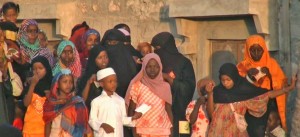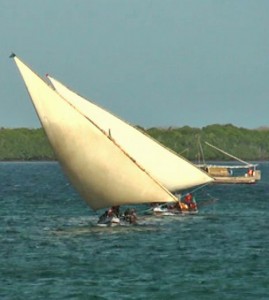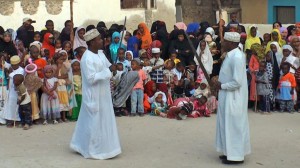The birthday of the Prophet Muhammad, or Mawlid an-Nabi, falls—for Sunni Muslims—on the twelfth day of the Islamic month of Rabi' al-Awwal. The event is celebrated widely in the Islamic world through a variety of religious and secular events, and in East Africa, the biggest of these celebrations is the Maulid, organised by the Riyadha Mosque in Lamu, Kenya.
This year Maulid itself was celebrated on February 16th, but the festivities and events in Lamu lasted for more than a week. Donkey races, dhow races, and various cultural activities, including the singing of qasidas and a koran memorisation contest, lent the town a carnival atmosphere, while free medical care and educational workshops represented more serious social aspects of the event.
Musical controversy in Lamu
The Lamu Maulid in its present form—this year’s was the 106th in Lamu—was established at the beginning of the 20th century by Habib Swaleh b. Alawi Jamal al Lail, a religious scholar of Hadrami (southern Yemeni) origin who arrived in Lamu from his birthplace in the Comoro Islands in the late nineteenth century. In 1889 he founded the Riyadha Mosque, which rapidly became a centre for learning. Habib Swaleh was anxious to disseminate Islamic knowledge among the ordinary people of the coast, often confronting the established religious order in Lamu as he did so.
In 1909 a new maulidi—a religious text singing the praises of the Prophet - was composed by the scholar Ali b. Muhammad al-Habshi in Seiyun, Hadramawt. This was the Simt al Durar, “string of pearls”. It was more musical, and included drumming, than the other maulidis in use at the time, and when Habib Swaleh first performed it in his mosque it caused some opposition among the conservative classes of the town. They complained to the head of the community, Sayyid Mansab b. Abdulrahman, that there was music in the mosque and Sayyid Mansab went to remonstrate with Habib Swaleh. The latter replied that Abubakar bin Salim himself, founder of one of the most respected lineages of Hadrami origin, had used music in the mosque and, mollified, Sayyid Mansab sanctioned Habib Swaleh’s maulidi, informing the town of his decision.
So what has all this to do with migration?
The dissemination of Islamic religious knowledge and practice throughout the Indian Ocean region has long been dominated by scholars of Hadrami origin. Hadramawt, an ancient centre of learning whose urban origins and scholarly traditions lie far back in the pre-Islamic period, is in the southeastern part of today’s Republic of Yemen, and from its ports traders, scholars and migrants have, for centuries, sailed to India, South East Asia and East Africa (see the blog, Sept).
Hadrami society is highly stratified and different social classes fulfilled different socio-economic niches. The class with the highest status is the sada, or sharifs: descendants of the Prophet Mohammed through his daughter Fatima and his grandsons Hussein and Hasan. Almost all sada in Hadramawt are descended from Ahmed ibn Issa al Muhajir al-Allah, who left Iraq for Hadramawt many centuries ago. They are the religious leaders, unarmed and educated, and they generally marry amongst themselves.
Below the sada are the mashaykh and the qabail, the leaders and the tribesmen; below them the masikin, the poor, and at the foot of the hierarchy the akhdam, the (former) slaves. These hierarchies are still highly important in Hadramawt, and also continue to shape relationships in the diaspora. And although the range of differences are recognised,
the crucial distinction remains that between sada and the others.
Individuals from all classes have migrated from Hadramawt, and are found fairly evenly represented across the Indian Ocean region; and although some from the lower classes, free from the social constraints that bound them in Hadramawt, have become highly successful in business, others less so. The poor are often unable to attend events like the Lamu Maulid and they therefore rely on the dissemination and the networking carried
out by the religious leadership to maintain links beyond their families.
Why was I there?
Religious networks are among the strongest of the glues that bind together the Hadrami diaspora. The sada form a closely linked transnational network whose members come together at events such as the Lamu Maulid (and there are others, such as the annual pilgrimage to the tomb of the Prophet Hud in Hadramawt). They renew old contacts, forge new ones, and return home to places where they are embedded within Hadrami communities that include individuals and families from all social strata. By proxy, therefore, these links that are renewed as local religious activities become nodes for the incorporation of local communities into the wider Hadrami diaspora. Using these contacts, diasporic Hadramis may then establish relationships with communities elsewhere in the diaspora, should they wish to do so.
The Lamu Maulid is still organised by the Riyadha Mosque and is the responsibility of the Badawy family, descendants of Habib Swaleh. Ahmed Binsumeit Badawy, great grandson of Habib Swaleh and a microbiologist at Sultan Qaboos University in Muscat, is the principal organiser of the event, opening his house in Lamu to guest from all over the world.
Members of his own family come from other parts of Kenya and the Gulf states. Other guests come from far and wide: from Hadramawt, of course, but from Europe, India, South Africa and the United States. My own presence was driven by a desire not only to see the Maulid—it was my first Lamu Maulid—but, like others, to establish contacts and make links with other members of the Hadrami diaspora that I may now follow up in other parts of East Africa, the Gulf and Europe. Through these contacts I then hope to meet other members of the diaspora, those who did not make it to Lamu, but who maintain relationships with those who did.



